🐞 Exoskeleton & Moulting
Insect Exoskeleton, Structure of Insect Integument, Moulting and Process of Moulting
Which of the following is not an insect protein?
Insect Morphology
- The branch of science which deals with the study of physical structure and form of insects is known as insect morphology.
- It encompasses the head, thorax, abdomen, legs, wings, and mouthparts of insects.
Insect Exoskeleton
- The external covering or body wall of the insect is made of hard polymer known as
Chitin. - This
ourtercovering acts as skeletan system of the insects, which is known asExoskeletaon. - Insect body wall is also known as Integument.
- It is rigid, flexible, lighter, stronger and variously modified in different body parts to suit different modes of life.
Functions of Insect Integument
- Acts as external armour 𐂫: The integument provides a strong, protective outer layer that helps to prevent damage to the insect’s external organs such as the jaws and ovipositor.
- Protects internal organs: The integument also helps to protect the insect’s internal organs, such as the foregut, hindgut, and trachea, from physical aberrations, injurious chemicals, parasites, predators, and pathogens.
- Supports muscle attachment and body shape: The integument provides space for muscle attachment, allowing the insect to move, and also gives shape to the body.
- Prevents water loss: The integument helps to prevent water loss from the body by reducing evaporation.
- Sensory organs: The integument contains sensory organs that help the insect to sense its environment.
- Provide colour: The integument can also contain pigments that give the insect its color.
Stucture of Integument
👉🏻 Insect Integument consists of 3 layers:
- Cuticle
- Middle Epidermis also known as Hypodermis
- Inner Basement Membrane

1. Basement membrane
- It is innermost
non-cellular layer of insect integument to which muscles are attached. - It is the basal part of the body wall formed from degenerated epidermal cells and appear as
non-living amorphous (shapeless) granular layer of integument.
2. Epidermis (Hypodermis)
- The layer above the basement membrane is known as Epidermis.
- It is a unicellular layer with active cells.
- The main function of epidermis is to secrete its above layer known as cuticle.
- All the epidermal cells are glandular and secrete cuticle and the enzymes involved in production and digestion of old cuticle during moulting.
- It is also involved in digestion & absorption of old cuticle and wound repairing
- The epidermal cells get differentiated in to following types based on the function they perform and may modify into:
- dermal glands producing cement layer
- trichogen cell producing hair like seta or trichome
- moulting glands secreting moulting fluid which digests the old cuticle
- peristigmatic glands around the spiracles in case of Dipteran larvae
3. Cuticle
- The outer most layer of the integument is known as cuticle.
- It is non-cellular, non-living layer and secreted by Epidermis (hypodermis).
- Cuticle is further divided into epicuticle and procuticle.
- Epicuticle is made of non-chitinous protein layer.
- Procuticle is having
chitinand protein layer.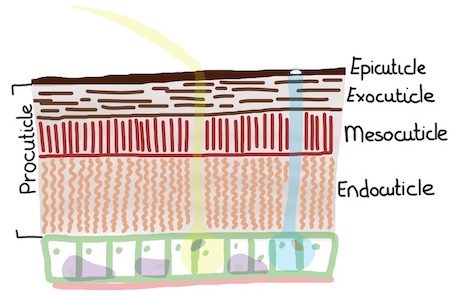
Composition of Cuticle
- It is made up of
chitin(35-60%) and protein (25-40%). - Chitin is a nitrogenous polysaccharide (carbohydrate) consists of several chains of N acetyl glucosamine and glucosamine residue. It is water insoluble but soluble in dilute acids, alkalies and organic solvents.
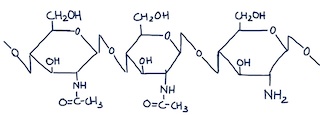
- Chitin is probably the second most abundant polysaccharide in nature after cellulose.
- Types of Proteins in Insect Integument:
Arthropodinis the main structural protein of insect which is untanned protein and soluble in water.Sclerotinis tanned cuticular protein that is water soluble.Resilinis an elastic protein responsible for the flexibility of wings sclerites. e.g., wing hinge ligaments, leg joints.
A. Epicuticle
- It is a thin outermost layer varying in thickness from 1-4μ (very thin). Chitin is absent in epicuticle.
- Pore canals present in the exocuticle helps in the deposition of epicuticle.
- This layer is differentiated into the following 4 layers (outside to inside):
- Cement layer: It is secreted by dermal glands and is composed of lipoprotein. It protects the body from external damage.
- Wax layer: It is prominent layer, 0.25μ in thickness, consisting of long chain hydrocarbons, esters of fatty acids and alcohols. It serves as waterproof layer preventing water loss from the body.
- Polyphenol layer: It is a non-static layer containing various types of phenols which are mainly used in the formation of the proteins. It is resistant to acids and organic solvents.
- Cuticulin layer: It is an amber coloured thin layer over the surface of the epidermis which is strengthened by outer polyphenol layer. It serves the purpose of permeability and also acts as growth barrier.
B. Procuticle
- It is differentiated into exocuticle and endocuticle after sclerotization process.
- Exocuticle is darkly pigmented, hard and sclerotized. It offers rigidity to the cuticle and consists mainly chitin and a hard protein called sclerotin.
- Endocuticle is soft, light coloured and unsclerotized. It contains more chitin but lacks hard protein sclerotin.
Pore canals
- These are numerous fine vertical channels traversing both exo and endocuticle measuring < 1μ (0.1 – 0.15μ) in diameter. They run perpendicularly from epicuticle throughout the length of the cuticle.
- They are useful in transportation of cuticular material and enzymes to the outer pro and epicuticle parts.
Cuticular/ Integumental modifications
- Cuticle/Integument is modified into external outgrowths or internal invaginations.
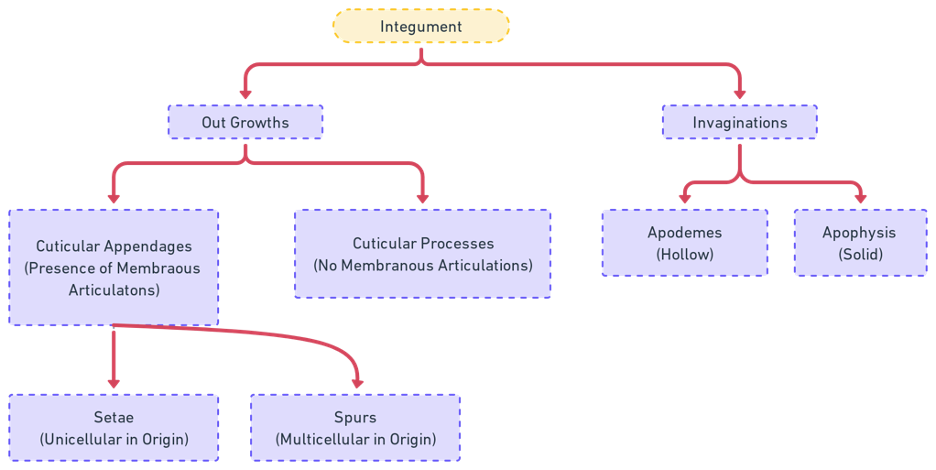
A. Cuticular Out growths
- They are divided into cuticular appendages and cuticular processes depending on the presence or absence of membranous articulations.
- I. Cuticular appendages: These are the outgrowths of the cuticle / integument connected with it by means of a membranous joint. They arise from modified epidermal cells. These are classified into setae and spurs.
- Seta/ Macrotrichia:
- Commonly known as hairs and arise from a cup like alveolus or pit. These are unicellular. Setae are hollow structures developed as extension of exocuticle and are produced by a single enlarged hypodermal cell called
trichogen cell. - Articular membrane is usually produced by a second hypodermal cell called ‘
tormogen cell(socket forming cell housing trichogen). Setae have role of taxonomic importance and vary with species to species. - Study of arrangement of setae is known as
chaetotaxy.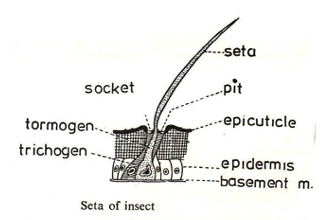
- Different kinds of setae are as follows:
- Clothing hairs: These are hair like structures that cover the entire body, legs and wings. Eg: honeybee. Bristles. e.g. flies
- Scales: These are varyingly pigmented plate like structures covering the body as well as wings of adult moths and butterflies.
- Glandular setae: Setae that functions as outlet for the secretion of hypodermal glands. If they are stout, they are called glandular bristles as in case of certain larvae of Lepidoptera.
- Sensory setae: These are the setae or trichomes provided with sensory receptors or sensory nerve cells and respond to the external stimuli. These are present on antennae, legs and mouth parts.
- Spurs: Occur on the legs of many insects and differ from setae in being multicellular in origin.
- II. Cuticular processes
- They have no membranous articulation.
- They are of two types:
- Microtrichia / fixed hairs / aculei: These are minute hair like structures found on wings of Mecoptera and certain Diptera.
- Spines: Outgrowths of the cuticle which are more or less thorn like in form.
B. Cuticular invagination
- The body wall or cuticle of the body wall invaginate internally and grow in to definite structures which are of two types.
- Apodemes:
Hollowcuticular invaginations which provide area for muscle attachment. - Apophyses:
Solidinvaginations of the cuticle which gives mechanical support to various organs by forming distinct skeletal structures.
Moulting

- Periodical process of shedding/casting of the old cuticle accompanied by the formation of new cuticle is known as moulting.
- It is necessary to growth of insect. The insect cuticle is hard, and forms un-stretchable exoskeleton and it must be shed from time to time to permit the insects to increase their size during growth period. Before the old cuticle is shed new one has to be formed underneath it.
- The cuticular parts discarded during moulting is known as
Exuvia. - Moulting occurs many times in an insect during the immatured stages before attaining the adulthood. The time interval between the two subsequent moulting is called as
Stadiumand the form assumed by the insect in any stadium is called asInstar.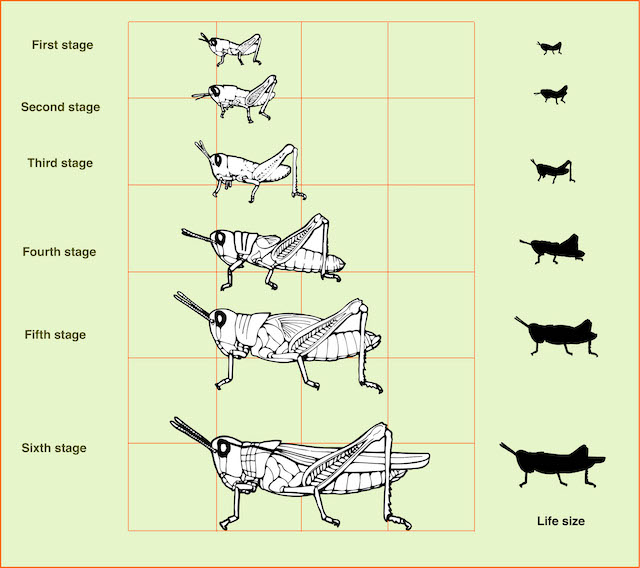
Process
- Moulting is a complex process which involve following three stages:
- Apolysis
- Ecdysis
- Sclerotization
1. Apolysis
- Apo means formation & Lysis means dissolution.
- The dissolution of old cuticle and formation of new one is known as apolysis.
- Apolysis starts with repeated mitotic division of epidermal cells resulting in increase in number and size of epidermis, which becomes columnar in shape and remain closely packed.
- Because of this change, the epidermal cells exert tension on cuticular surface and as a result get separated themselves from the cuticle.
- Due to separation of epidermis from the cuticle a sub-cuticular space is created and the epidermal cells starts producing their secretion i.e., moulting fluid and cuticular material into this space.
- The moulting fluid is granular, gelatinous and contains two enzymes viz., proteinase and chitinase which can dissolve the old cuticle.
- As the moulting fluid digest the old cuticle, the sub cuticular space increases gradually by the same time and is occupied by the newly formed cuticular layer, the polyphenol layer, wax layer and cement layer into the deposition of definite layers of epicuticle.
- Procuticle get deposited beneath the epicuticle and subcuticular space is fully occupied.
- Though moulting fluid is capable of digesting the entire endocuticle, some undigested old exo and epicuticle portions will remain as a layer in the form of an ecdysial membrane.
2. Ecdysis
- The stage where the insect has both newly formed epicutilce & procuticle and old exocuticle and epicuticle is known as
pharate instar. - The ecdysial membrane starts splitting along the line of weakness due to muscular activity of the inner developing insect and also because of swallowing of air & water resulting in the distention of the gut.
- The breaking at the ecdysial membrane is also due to the pumping of blood from abdomen to thorax through muscular activity.
- After the breakage of old cuticles which is known as exuviae, the new instar comes out bringing its head followed by thorax, abdomen, and appendages.
2. Sclerotization
- After shedding of old cuticle the new cuticle, which is soft, milky white coloured becomes dark and hard through the process known as tanning or sclerotization.
- The process of hardening involves the development of cross links between protein chains which is also known as sclerotization. This tanning involves the differentiation of procuticle into outer hard exocuticle and inner soft endocuticle.
Moulting Hormones
- Three types of hormones involved in the process of moulting which are as follows:
- Juvenile Hormone (JH): Produced from corpora allata of brain that helps the insects to be in immature stage.
- Moulting Hormone (MH): Produced from prothoracic glands of brain that induces the process of moulting.
- Eclosion Hormone: Released from neurosecretory cells in the brain that help in the process of ecdysis or eclosion.
References
- Insecta - Introduction: K.N. Ragumoorithi, V. Balasurbramani & N. Natarajan
- A General Textbook of Entomology (9th edition, 1960) – A.D. Imms (Revised by Professor O.W. Richards and R.G. Davies). Butler & Tanner Ltd., Frome and London.
- The Insects- Structure and Function (4th Edition, 1998) – R.F. Chapman. Cambridge University Press
- Wikipedia
-
Which of the following is not an insect protein?
Insect Morphology
- The branch of science which deals with the study of physical structure and form of insects is known as insect morphology.
- It encompasses the head, thorax, abdomen, legs, wings, and mouthparts of insects.
Insect Exoskeleton
- The external covering or body wall of the insect is made of hard polymer known as
Chitin. - This
ourtercovering acts as skeletan system of the insects, which is known asExoskeletaon. - Insect body wall is also known as Integument.
- It is rigid, flexible, lighter, stronger and variously modified in different body parts to suit different modes of life.
Functions of Insect Integument
- Acts as external armour 𐂫: The integument provides a strong, protective outer layer that helps to prevent damage to …
Become Successful With AgriDots
Learn the essential skills for getting a seat in the Exam with
🦄 You are a pro member!
Only use this page if purchasing a gift or enterprise account
Plan
Rs
- Unlimited access to PRO courses
- Quizzes with hand-picked meme prizes
- Invite to private Discord chat
- Free Sticker emailed
Lifetime
Rs
1,499
once
- All PRO-tier benefits
- Single payment, lifetime access
- 4,200 bonus xp points
- Next Level
T-shirt shipped worldwide

Yo! You just found a 20% discount using 👉 EASTEREGG

High-quality fitted cotton shirt produced by Next Level Apparel